Recapping “The Jetsons”: Episode 01 – Rosey the Robot
Meet George Jetson! The first installment of our 24-part series on the show that would forever change how we view the future
![]()
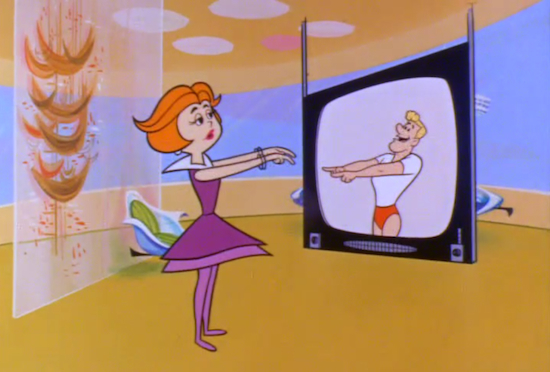
Jane Jetson working out her strained fingers in the premiere episode of “The Jetsons” (1962)
This is the first in a 24-part series looking at every episode of “The Jetsons” TV show from the original 1962-63 season.
Episode 01: “Rosey the Robot,” originally aired: September 23, 1962
If you flipped through the Cedar Rapids Gazette on September 23, 1962 the news looked fairly typical for the early 1960s.
There was a short item about a Gandhi memorial being planned in London. There was an article about overcrowded schools and the need for new junior high schools, since the baby boom had inundated the schools and enrollment in the Cedar Rapids public school system was increasing by about 1,000 students each year.

Newspaper ad for color TV in the September 23, 1963 Cedar Rapids Gazette
The Gazette also had an editorial about “lame-brain bigots” in Georgia who were burning down black churches, and a column about the fact that one out of every 38 children born in Linn County in 1961 was born out of wedlock. The paper had recipes for poached eggs and peas with lemon butter sauce, as well as ads for the Smulekoff’s furniture store imploring you to buy a brand new color TV—with prices starting as low as $495 (about $3,500 adjusted for inflation).
But tucked away within the TV listings for that week was the mention of a show that would radically shape the way Americans would talk about the future for decades to come. The newspaper had an article about the arrival of color on ABC’s Cedar Rapids affiliate, KCRG channel 9. NBC had been “carrying the color ball almost singlehandedly” for years in Cedar Rapids but starting that evening, ABC would join the color fray with a new show called “The Jetsons.” At 6:30 pm that night “The Jetsons” would debut against “Dennis the Menace” on channel 2, “Car 54 Where Are You?” on channel 6, and the season premiere of NBC’s immensely popular “Walt Disney’s Wonderful World of Color” on channels 7 and 13.
Of course, it wasn’t just the people of Cedar Rapids who were tuning in on Sunday to watch a middle class family stumble through modern life in the year 2062. People all over the United States got their first taste of the Jetsons’ vision for tomorrow on that autumn evening.
Push-Button Living
There’s perhaps nothing more Jetsonian than the push-button. Jane Jetson pushes buttons to make dinner, to clean the home, and even to wake up her husband George. The running gag throughout the entire series is that the only thing George does all day at work (all three hours of it) is push a button.
From the very first scene of the first episode we learn precisely how difficult the people of the future have it. Jane Jetson is standing in front of a flat panel “3D” TV and conducting a strenuous workout — of her fingers. Of course, we’re meant to laugh at the fact that people of the year 2062 are living in the lap of luxury needing only push a button to accomplish what used to take hours, but it was also a subtle jab to those viewers at home who may complain about how difficult life is when all the modern conveniences of 1962 were at their disposal.
It’s important to recall that some scholars have argued that modern appliances didn’t actually save nearly as much time as originally envisioned. That’s because these gadgets impose higher standards of household efficiency and cleanliness—we take it for granted that our closets will always be filled with clean clothes; that our yards should boast perfectly maintained lawns and gardens; that our shiny kitchen appliances will make it possible to enjoy diverse and tasty meals. Many people today question this same line of thinking about technological progress, arguing that computers and smartphones have made us more productive, but that the standards for how much one person needs to accomplish have simply risen with it. Not to mention the “always available” culture that our devices have cultivated.
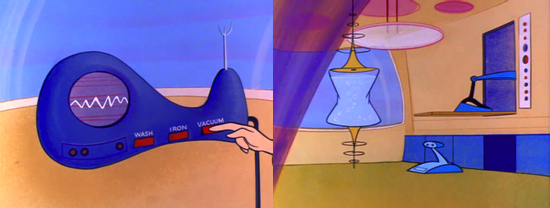
Two screenshots from The Jetsons showing Jane Jetson doing housework
While we often associate leisurely push-button living with the Jetsons, longtime readers of Paleofuture will know that this futuristic cartoon family didn’t invent the concept. In December 1950 an Associated Press article ran in newspapers across the country that gave readers a peek at the year 2000. Experts across all kinds of fields were consulted and the article took it as a given that the American home of the future would be much more automated than it was mid-century:
People will live in houses so automatic that push-buttons will be replaced by fingertip and even voice controls. Some people today can push a button to close a window – another to start coffee in the kitchen. Tomorrow such chores will be done by the warmth of your fingertip, as elevators are summoned now in some of the newest office buildings – or by a mere whisper in the intercom phone.
But, as is often the case in the Jetsons’ world, the gadgets of tomorrow in the premiere episode don’t always work as they were intended. Gadget malfunction is rampant and a source of financial stress in the Jetson home, recalling an article in the Chicago Tribune Sunday Magazine just a few years earlier.
Writing in the September 13, 1959 Chicago Tribune, Evelyn Zemke projects herself into the futuristic world of the year 2000. The “pizza for breakfast?” bit is nearly identical to what we see play out in the Jetson household during the premiere episode.
“Call a service man,” my husband always says when one of our appliances refuses to function.
Sounds simple enough, doesn’t it? Well, it is. At the very worst, probably only the washer, dryer, dishwasher, and TV would give up one day. But what about the housewife of the future – say of the year 2000, when the electronic era will be at its peak?
I can just picture myself in her place - ready to start another care-free day sitting around reading a science fiction thriller while the gadgets do all the work. Already the electronic brain in my kitchen is busy preparing and serving breakfast.
My husband, arriving at the table exclaims, “Pizza? For breakfast?”
“I pushed the button labeled BACON AND EGGS, but-”
“There’s a wire crossed somewhere. Call a service man.”
After doing so, I dispose of the garbage in the electronic disposal unit and pile the dishes in the ultra-sonic dishwasher. Then, after pushing the button which starts the electronic vacuum cleaner, I go out to the garage to set the timer for our radar controled lawnmower.
“Ki-yi-yi!” Sounds like Fifi, our pet poodle.
My daughter, standing in the doorway, calls, “Mom! The cleaner is vacuuming Fifi!”
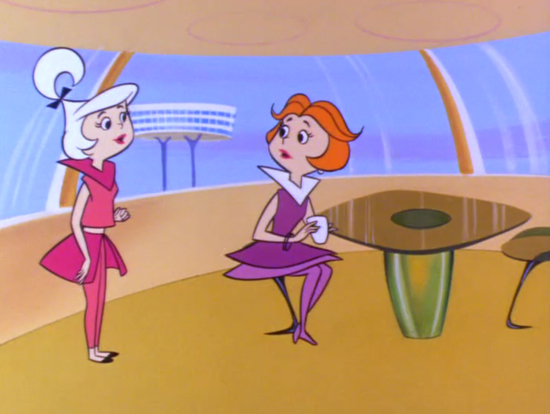
Judy and her mother Jane Jetson in their home in the premiere episode “Rosey the Robot”
Baby Boom
The premiere episode also shows viewers an interaction with Jane and her daughter Judy that hints at what would later be called the generation gap. Many of the same fears parents have here in the 21st century about their kids “growing up too fast” were splashed across popular media of the 1960s. The August 10, 1962 issue of Life magazine ran the story “Boys and Girls Too Old Too Soon: America’s Subteens Rushing Toward Trouble.” The story included a provocative photo essay showing 12 and 13-year-olds going on dates and engaging in “heavy necking.”
In the 1950s and ’60s the teenager and “subteens” (what we today might call a tween) became a force to be reckoned with. There was suddenly a group of kids larger than any American generation that had come before it, and this had a dramatic ripple effect throughout our society. In Cedar Rapids, Iowa — like hundreds of other communities across the U.S. — that meant building more schools. And for the burgeoning medium of television, that meant delivering storylines which sometimes reflected the growing pains of what was held up as the model American family.
Slidewalks of Tomorrow
As we looked at this past January, the idea of abundant moving sidewalks in the city of tomorrow predates The Jetsons by over half a century. But some of the more interesting mid-century examples, which likely influenced The Jetsons, came from TV and Sunday comic strips. The Disneyland TV episode “Magic Highway, U.S.A.,” which aired on May 14, 1958 looks like it may have inspired the Jetsons’ slidewalks of the future. The show also likely drew inspiration from print media, like the Sunday comic strip “Closer Than We Think,” which you can see below.
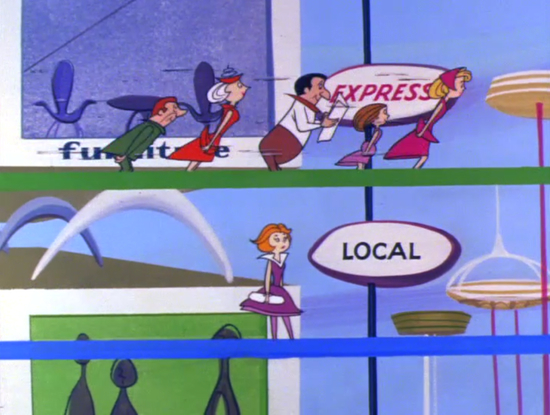
Jane Jetson on a moving sidewalk in the premiere episode of The Jetsons
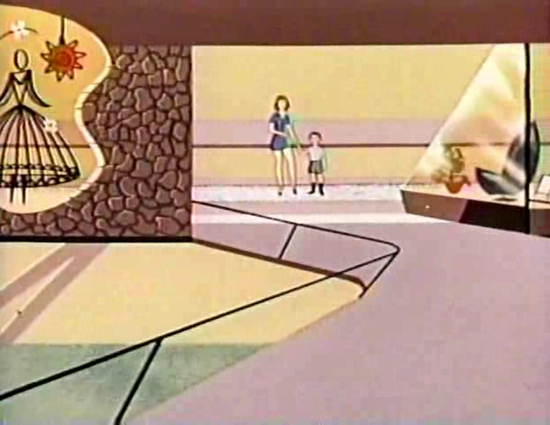
Moving sidewalk of the future in the 1958 Disneyland TV episode “Magic Highway USA”
The June 7, 1959 edition of Arthur Radebaugh’s Sunday comic strip “Closer Than We Think”:
The large malls planned for tomorrow’s metropolitan centers will not be tied up with vehicular traffic. Shoppers and sight-seers will be transported by mobile sidewalks that closely resemble giant conveyer belts. Parcels to be delivered will be carried by overhead rail to trucks on the area’s perimeter.

Moving sidewalk in the June 7, 1959 comic “Closer Than We Think”
Hello Rosey
An interesting detail that’s established in the first episode, but isn’t necessarily carried throughout the series, is that the robot maid of the year 2062 is considered a luxury item. One of the reasons that Jane buys Rosey instead of the more “distinguished” robots (shown as distinguished by simply having British and French accents) is that the Jetsons simply can’t afford anything more expensive.
Rosey the robot maid is perhaps the most iconic futuristic character to ever grace the small screen. Rosey is high-tech, but she’s also fallible. The mere fact that I use “she” rather than “it” speaks to what she represented — the humanoid robot helpers of our future, imperfect as they may be. And strangely, she doesn’t play a very prominent role in the first season of “The Jetsons.” The premiere episode establishes that Rosey is a valued member of the Jetson family, but as you’ll see over the course of this blog series, she doesn’t get a lot of screen time. Perhaps because she was so beloved by kids who saw her on reruns during the 1960s, ’70s and early ’80s she receives a much more prominent role in the 1985 reboot.
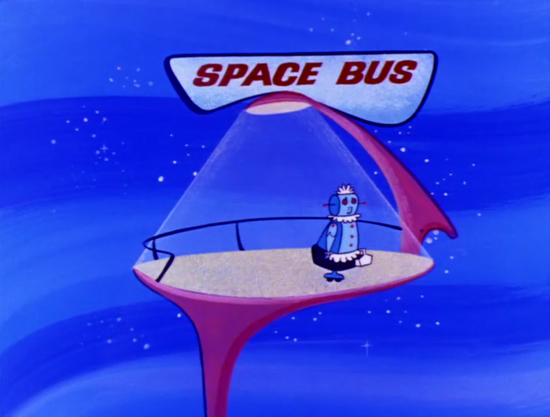
Rosey the robot maid waits for the Space Bus in this screenshot from “Rosey the Robot”
If you own the first season DVDs or watch it online you may notice that the first season has title cards which include Orbitty, a character that wasn’t introduced until the 1980s reboot. Knowing that the episode title slates on my DVD copy of “The Jetsons” were from the 1980s, I went down to the Paley Center for Media in Beverly Hills a few months back to see if I could find any clues about the true spelling of “Rosey.” As I mentioned last week, there has been some confusion about the proper way to spell the name. The Paley Center has an enormous collection of old TV and radio programs and sure enough, they have a copy of the first episode of “The Jetsons.” I was a little surprised to learn that the first season wasn’t aired with individual title slates, but I found some vindication in my spelling of “Rosey” in a 1962 board game that was on display.
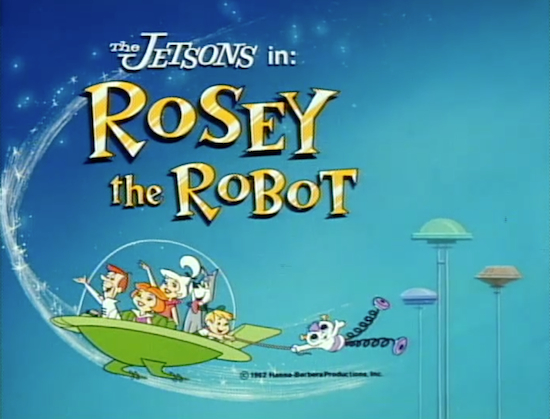
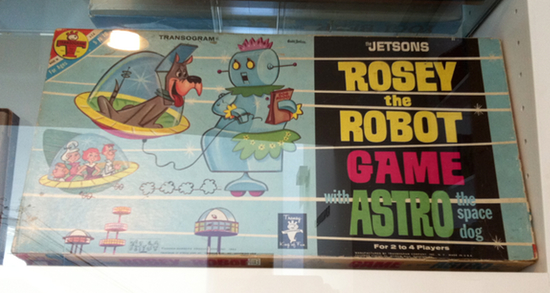
Jetsons board game released in 1962 (cameraphone photo taken at Paley Center for Media in Los Angeles)
Reception
Reviews of The Jetsons were generally positive on the day following its premiere, with Rick Du Brow from the UPI calling the show a “genial time killer.” But as we looked at last week, the show suffered from a tough time slot (in most markets it was up against the established powerhouse that was “Walt Disney’s Wonderful World of Color”) and a relative blandness when viewed in black and white, as most Americans did in 1962.
The Cedar Rapids Gazette‘s article about the new influx of color TV programming in Cedar Rapids proclaimed that “this year should be a coming-up-roses year for those who believe that television minus color is like the sky without blue.” Writer Nadine Subtonik acknowledged that it was still expensive but that if kids hound their parents enough “making Mom and Dad’s life miserable” then widespread color TV adoption was a certainty in the near future. But how many color sets were in the Cedar Rapids area at the time? “A quick survey the other morning convinced me of only one thing: Nobody has the faintest idea!”
There are a number of different technologies and subtleties within the Jetsons world that I didn’t touch on in this post, but just know that this was by design. While writing this post I came to realize that if I try to reference every gadget or social anachronism I’ll wind up with 24 novel-length posts and nobody wants to read that. We have 23 more of these to go, so please be patient if I missed your favorite doodad or whatsit. We’ll likely get to it in a future post. And thanks for reading!
/https://tf-cmsv2-smithsonianmag-media.s3.amazonaws.com/accounts/headshot/matt-novak-240.jpg)
/https://tf-cmsv2-smithsonianmag-media.s3.amazonaws.com/accounts/headshot/matt-novak-240.jpg)